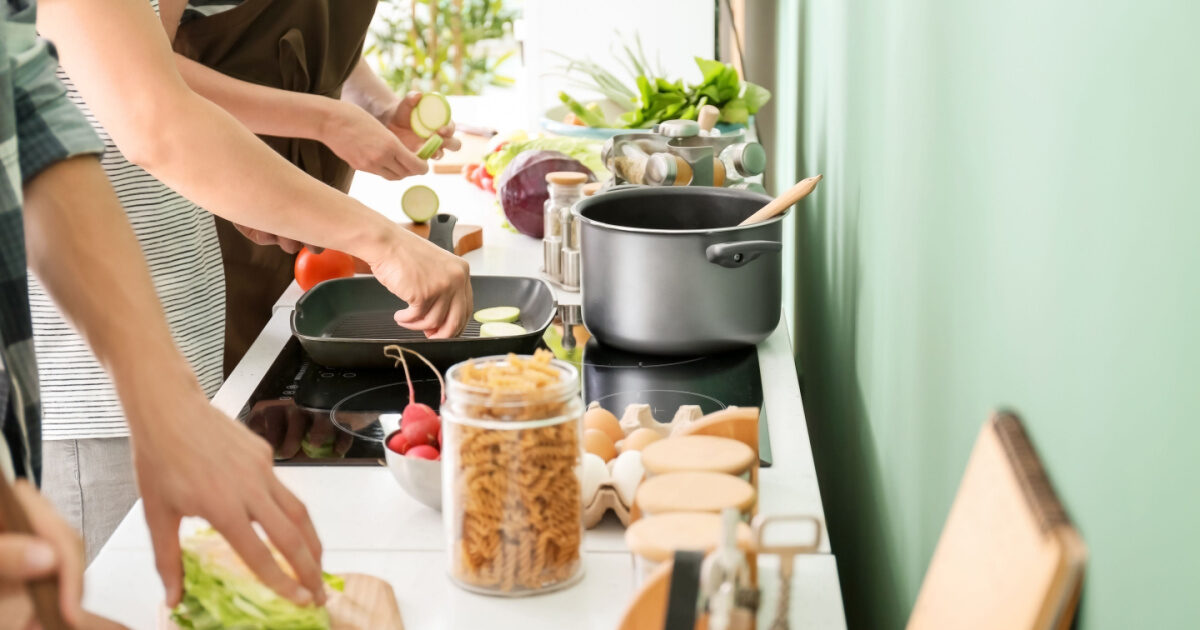Your guide to cooking in a shared house

What happens when you have multiple people trying to do the same thing in a cramped space? If you’re house sharing, the result can be an unclean kitchen, crowded shelves and hangry housemates.
We know how hard it can be to navigate healthy cooking in a shared house with limited free time between work and social lives, so we’ve put together our top 10 tips for happy healthy cooking:
1. It’s good to talk
Communication is key when it comes to sharing a kitchen with others. Talk about standards and expectations, check in with each other about who owns what and what food might need to be eaten (or thrown out). Having an open dialogue will keep the kitchen running smoothly.
2. Share the wealth
There’s a few of you in the house, which can really pay off when it comes to the kitchen! Instead of everyone having their own ‘one of everything’, have shared ingredients you all use and split the cost – saves you money and space in the cupboards.
3. Have the right tools
Check what you have and see if you need to do a collective ‘kitchen shop’. Items you can share include:
- coloured chopping boards to avoid cross contamination
- a compost bin for food waste
- utensils like weighing scales, measuring spoons and jug, knives, food processor, wooden spoon, spatula, vegetable peeler, can opener and cooking tongs
4. Be mindful of others
Does anyone in your house have a food allergy or intolerance? Be mindful of those you’re sharing kitchen space with. If someone has a food allergy or intolerance, you could have designated chopping boards, pans, utensils and even countertop to avoid any cross contamination. Also check ingredients before sharing or ordering food, to be sure it does not contain any food allergens you or your housemates need to avoid.
5. Clean as you go
It’s always good to be tidy and practise good hygiene etiquette to keep your housemates happy. If everyone starts and ends with a clean countertop when cooking, no one has to do extra cleaning.
Always clean with hot soapy water especially counters, chopping boards and utensils particularly after handling meat, seafood, fish or other raw meat. This will help avoid cross contamination and prevent food poisoning. And make sure to wash your dishcloths, sponges and tea towels regularly.
6. Mind the fridge
In a shared kitchen, a shared fridge is a given, with everyone usually assigned a shelf or space within the fridge. To keep food fresh, be careful to never overfill the fridge, as this can cause the air to not circulate properly and food to go off.
Most importantly always organise your fridge so that raw meat is on the bottom shelf. This ensures that it can’t contaminate fresh or ready-to-eat food.
7. Plan to your space
Only have one shelf in the fridge? Pull the short straw and get the small cupboard? Only buy food that you can store safely. An overpacked fridge, means food may not stay chilled. This could lead to food spoilage or food poisoning. Avoid wasting food, food poisoning or causing upset by planning your meals according to the space you have.
8. Have designated cooking nights
If everyone in your household wants to cook at overlapping times, it can be good to designate cooking nights to each housemate. On your designated nights, meal planning can help you optimise your time and be prepared for the week ahead.
Alternatively, as a household you can designate nights where you all cook together – sharing the work, and saving on ingredients and time!
9. Use up leftovers
If you prepare enough food for leftovers, make sure you label with the date, store within 2 hours of cooking and use within 3 days of cooking. Before doing a food shop, make sure to use up what you have and enjoy leftovers safely (only reheat once).
10. Choose recipes carefully
Finally, if everyone wants to cook their own dinners, it can be helpful to choose recipes that use minimal utensils and take little time, to speed up your stay in the kitchen.
Read more about keeping your food safe in your fridge

